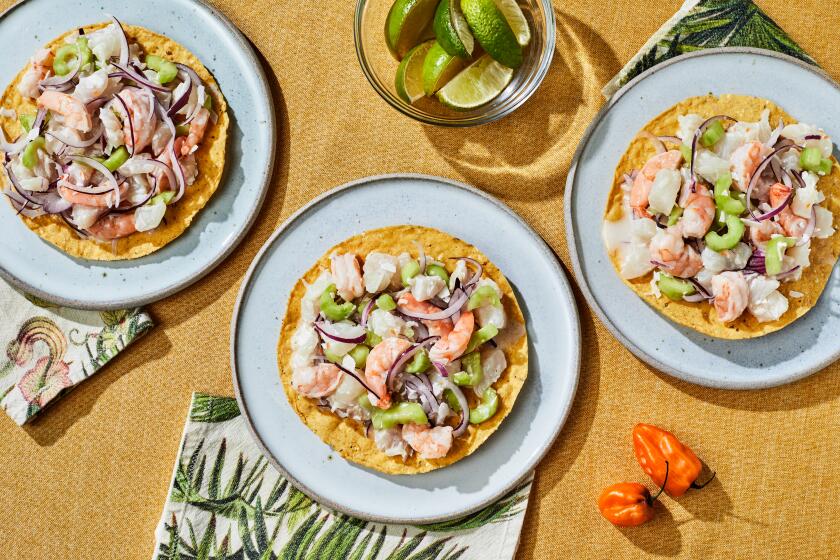Oysters Kirkpatrick

Years ago, the San Francisco Chronicle explained how to be a California old-timer. In San Francisco, you should say, “I can remember when this was ... a little joint called Luigi’s! And you could get veal, pasta, minestrone, spumoni and a bottle of Chianti, all for a buck!”
Anybody who’s lived in the Bay Area knows how San Franciscans caress the memory of their restaurants. Old-timers are forever reminiscing about dear old places, and if you never went there, you just have to take their word that something named the Fly Trap or the Poodle Dog really was a restaurant where you’d have wanted to eat.
Among the places that survive, none is dearer, or older, than the one John Briscoe writes about in “The Tadich Grill: The Story of San Francisco’s Oldest Restaurant, With Recipes” (Ten Speed Press, $27.95). In fact, as Briscoe points out, Tadich’s has the longest continuous history of any restaurant in the country outside New York or New Orleans. It goes back to a Gold Rush-era coffee stand (unmemorably named the Coffee Stand) located on a wharf that eventually turned into Commercial Street, as San Francisco Bay was partly filled in.
Since 1849, it has had seven locations, all within three of blocks of Commercial Street, and about a dozen owners, all of Croatian ancestry. Mostly they came from the Dalmatian coast, as have the Croatian fishermen who have settled in San Pedro. Today it’s the quintessential old-time businessman’s restaurant -- ever bustling, yet inimitably aged in the wood -- for downtown San Francisco, a convenient three blocks from the Montgomery Street financial district.
Briscoe hasn’t been able to find out a whole lot about what, apart from coffee, the oldest antecedents of Tadich served, but early on it made a specialty of seafood. And in 1925, it started grilling fish over mesquite charcoal (well ahead of the fashion trend, you really have to agree). Cooking fish over hardwood, traditional in Croatia, was new to San Francisco, where fish had only been fried, baked or poached. Tadich’s had already been using charcoal for other purposes, though, presumably for baking, because it has been buying its charcoal from the same supplier for a hundred years.
The oldest tradition the place has is never taking a reservation. No matter who you are, you wait till they call your table. There’s no more San Francisco sight than a gaggle of stockbrokers and city hall players, who could easily reserve a table at any other restaurant in town, noisily milling around at Tadich’s, sipping Ramos fizzes and listening for their names to be called.
Along with waiters’ and customers’ reminiscences about Tadich’s over the years, Briscoe has included a good deal about San Francisco history (the Gold Rush, the eccentric known as Emperor Norton, earthquake tales). You can look on this as useful historical background or just more of the city’s endless infatuation with itself, but the nostalgia never gets too thick. Not altogether too thick, anyway.
About a third of the book is recipes, 35 of them, almost all for seafood but with room for two beef dishes and the elementary baked apples that have been on the menu for more than a century. Though one fashionable-looking recipe incorporates pineapple-mango salsa, most are venerable house favorites like crab and prawns a la Monza (it turns out nobody really knows who Monza was) and pan-fried sand dabs, which is what I’ve usually ordered at Tadich Grill. As is typical with seafood recipes, they’re based on showcasing the freshness of the ingredients, rather than a chef’s creativity.
The most valuable thing here, apart from the recipes, is the story of a restaurant that has kept a loyal clientele for an amazingly long time. It has clearly been doing something right for people to come to a plain, dark-paneled place with not much on the walls but coat hangers and a menu that shifts about as fast as your average glacier.
In the early ‘80s I mentioned to The Times’ restaurant reviewer, Lois Dwan, that people eat out more often in San Francisco than they do here. “Yes,” she said, “but they always go to the same places, and they always order the same things.”
Back then, with Los Angeles chefs beginning a spree of wild creativity and our restaurant scene pulling ahead of San Francisco’s in terms of sheer electricity, that attitude seemed absurdly stodgy.
It has its virtues, though. When you’ve been doing pretty much the same thing for more than a century, you tend to get it down.
The recipes in this book may look simple, but it would be more accurate to say that all the rough edges were worn off them decades ago; they’re as smooth and solid as river pebbles.
Heat the oven to 450 degrees.
Fry the bacon in a skillet over medium heat until crisp, 6 to 8 minutes. Transfer to paper towels to drain, then crumble.
Melt the butter in a skillet over medium-low heat without stirring. When it’s completely melted, reduce the heat to low and simmer 5 minutes. Skim the white foam off the top. Pass through a fine-mesh sieve, reserving the clear yellow liquid and discarding the solids.
Shuck the oysters, straining and reserving the liquid. Discard the shallow halves of the shells and scrub and dry the deep halves. Pour the rock salt into large baking dishes and arrange the shells on top. Place 1 oyster in each shell. Sprinkle the oysters with the bacon. Mix the reserved oyster liquid with the clarified butter, ketchup and bell pepper and pour equal amounts over the oysters. Sprinkle the tops with the cheese. Bake 5 to 7 minutes. To brown the cheese, place under the broiler 2 to 3 minutes. Serve immediately.
Get our Cooking newsletter.
Your roundup of inspiring recipes and kitchen tricks.
You may occasionally receive promotional content from the Los Angeles Times.















